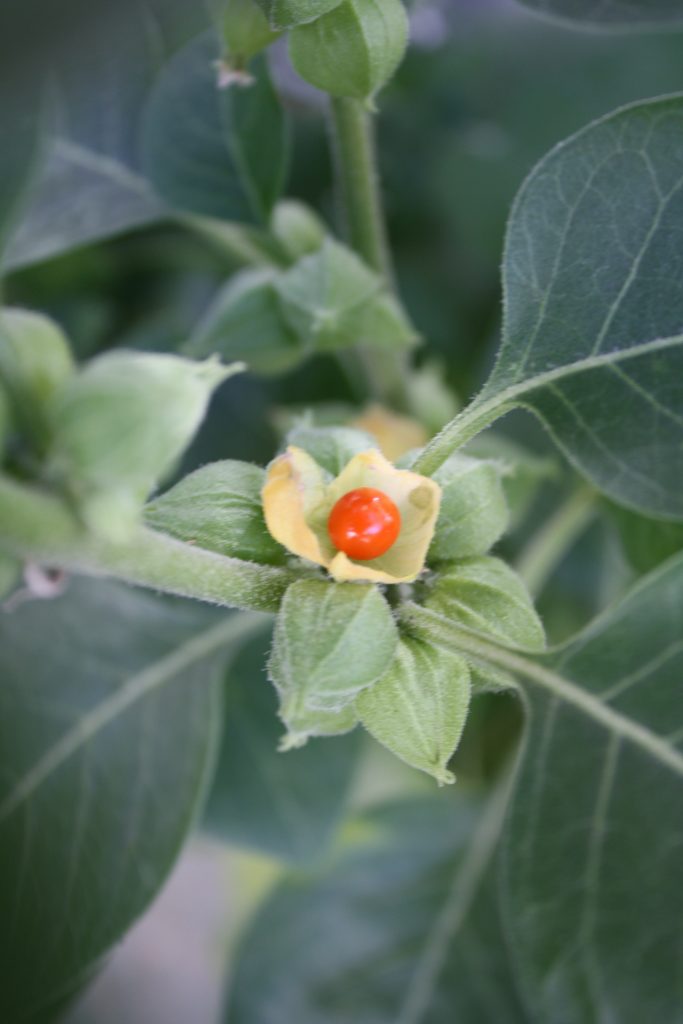 Withania (Withania somnifera) is a perennial plant that belongs to the Solanaceae or nightshade family. Other names for Withania include ashwagandha, winter cherry, poison cherry and Indian ginseng. The plant grows to about 75 cm in height, and large leaves up to 12 cm in length radiate from a central stem. Withania produces small green bell-shaped flowers and an red orange fruit. Withania has a 2500 year history of use in Ayurvedic medicine, where it is used as a nervous tonic. The root of the plant is considered medicinal, and it is this part that is dried and used for its beneficial health effects. Like Panax ginseng, withania is considered an adaptogenic herb, whereby it confers protection to the consumer against adverse environmental stressors. As stress is a major contributory factor in the promotion of depression, herbs that can reduce this impact of stress may be particularly useful in dealing with depressive symptoms. In this way the withania is able to promote physical and mental well being, including elevations in mood and cognition.
Withania (Withania somnifera) is a perennial plant that belongs to the Solanaceae or nightshade family. Other names for Withania include ashwagandha, winter cherry, poison cherry and Indian ginseng. The plant grows to about 75 cm in height, and large leaves up to 12 cm in length radiate from a central stem. Withania produces small green bell-shaped flowers and an red orange fruit. Withania has a 2500 year history of use in Ayurvedic medicine, where it is used as a nervous tonic. The root of the plant is considered medicinal, and it is this part that is dried and used for its beneficial health effects. Like Panax ginseng, withania is considered an adaptogenic herb, whereby it confers protection to the consumer against adverse environmental stressors. As stress is a major contributory factor in the promotion of depression, herbs that can reduce this impact of stress may be particularly useful in dealing with depressive symptoms. In this way the withania is able to promote physical and mental well being, including elevations in mood and cognition.
Animal studies have investigated the effects of withania on the ability of animals to withstand stress. For example, in one study, animals were fed standardised extracts of withania for 21 days. The standardised extract contained 28 to 30 % withanolides, with withaferin being the major active component. The rats were then exposed to stressful environmental conditions including mild electric shocks. The stressful conditions cause significant changes to the animal’s physiology including increases in blood glucose levels, the release of stress hormones, gastric ulceration, male sexual dysfunction, reductions in cognitive capacity, reductions in immune capacity and depression. These effects were significantly attenuated in the group of rats given withania, suggesting that phytochemicals in the extract were able to reduce the effects of the stress. Another group of rats were given Panax ginseng and these rats also experienced an attenuation of the detrimental effects of the stress, suggesting the two plants have similar effects.

The phytochemicals present in the Withania plant include a number of alkaloids including tropine and cuscohygrine. In addition, there are steroidal lactones called withanolides with withaferin A being one such compound that has been isolated. These compounds are a structurally similar group to the steroidal saponins found in ginseng, sour date and mimosa. This may explain their similar adaptogenic properties of all these plants to the application of stress. Evidence suggests that the effects of withania may be through interaction with the benzodiazepine receptor. This may explain why withania exhibits anxiolytic effects similar to those exhibited by the anxiolytic benzodiazepine drug lorazepam. Image from: owbobwow12 at English Wikipedia [GFDL (http://www.gnu.org/copyleft/fdl.html), via Wikimedia Commons.
Withania has also been shown to have anxiolytic effects in animals comparable to pharmaceutical drugs. For example, rats administered withania extracts containing withanolides had significant reductions in the anxiety they experienced when exposed to stressful conditions. In this regard, the withania was as effective as the benzodiazepine drug lorazepam. Both the withania and the lorazepam was administered as a single dose 30 min prior to the application of the stress, and so this indicates that withania may have short term beneficial effects, similar to ginseng. Biochemical analysis of the rat’s brains indicated that both lorazepam and withania reduced brain levels of a endocoid, a marker of clinical anxiety. In addition to the effects on anxiety, administration of withania also demonstrated antidepressant effects in the rats comparable to that of the tricyclic antidepressant drug imipramine. Withania therefore has been shown to have beneficial mood stabilising effects in animal models.
Eat Well, Stay Healthy, Protect Yourself
RdB
